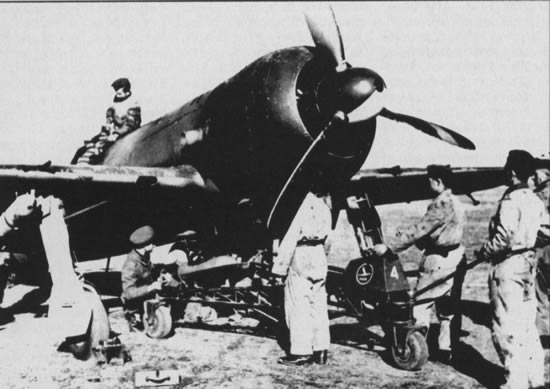
|
|
|
|
|
|
|
|
|
|
|
|
|
|
|
|
|
|
|
|
|

Fitting the main bomb on a IAR-81 fighter-bomber
|
Technical data of the IAR - 81
|
Wingspan
|
10.52 m
|
|
Length
|
8.97 m
|
|
Height
|
3.525 m
|
|
Weight (empty)
|
2200 kg
|
|
Weight (loaded)
|
3125 kg
|
|
Maximum speed at 5000 m
|
465 km/h (bomber)/505 km/h (fighter) |
|
Climbs to 5000 m
|
7 minutes and 30 seconds (bomber)/6 minutes and
30 seconds (fighter)
|
|
Maximum operational ceiling
|
10000 m
|
|
Range
|
695 km (bomber) / 730 km (fighter) / 1330
km with external fuel tanks
|
|
Engine
|
IAR 14K IV C32 1000A1 rated at 1025 HP
|
|
Armament
|
6 FN 7.92 mm machine guns
|
|
Payload
|
One 225 kg bomb plus 2x50 kg bombs
|
|
Numbers produced
|
50
|
|
Serial numbers
|
91-105 ; 151-175
|
|
|

An IAR-81A fighter-bomber is being loaded with a 250 kg bomb. East front, 1943
Technical data of the IAR - 81A
|
Wingspan
|
10.52 m
|
|
Length
|
8.97 m
|
|
Height
|
3.525 m
|
|
Weight (empty)
|
2190 kg
|
|
Weight (loaded)
|
3190 kg
|
|
Maximum speed at 5000 m
|
465 km/h (bomber)/505 km/h (fighter) |
|
Climbs to 5000 m
|
7 minutes and 30 seconds (bomber)/6 minutes
and 30 seconds (fighter)
|
|
Maximum operational ceiling
|
10000 m
|
|
Range
|
695 km (bomber) / 730 km (fighter) /
1330 km with external fuel tanks
|
|
Engine
|
IAR 14K IV C32 1000A1 rated at 1025 HP
|
|
Armament
|
2 FN 13.2 mm machine guns plus 4 7.92 mm machine guns
|
|
Payload
|
One 225 kg bomb plus 2x50 kg bombs
|
|
Numbers produced
|
10
|
|
Serial numbers
|
291-300
|
|

IAR-81C's on readiness ( late 1943 )
|
|
|
Technical data of the IAR - 81C
|
Wingspan
|
11 m
|
|
Length
|
8.97 m
|
|
Height
|
3.535 m
|
|
Weight (empty)
|
2200 kg
|
|
Weight (loaded)
|
2900 kg
|
|
Maximum speed at 5000 m
|
505 km/h (fighter) |
|
Climbs to 5000 m
|
7 minutes
|
|
Maximum operational ceiling
|
10000 m
|
|
Range
|
730 km / 1330 km (with external fuel tanks)
|
|
Engine
|
IAR 14K IV C32 1000A1 rated at 1025 HP
|
|
Armament
|
2 Mauser MG 151/20 mm cannons plus 4x7.92 mm FN machine
guns
|
|
Numbers produced
|
150
|
|
Serial numbers
|
301-450
|